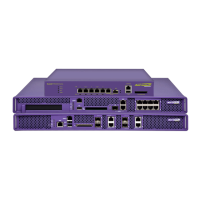Summit WM3000 Series Controller System Reference Guide 283
For example, for a cluster of three controllers (S1 = 6, S2 = 6 and S3 = 6 licenses), the group license
count is 18. If S1 goes down, the license count is still 18, since the license calculation is not initiated if
a member controller goes down. If S4 (with zero licenses) is introduced, S4 becomes part of the
group (can exchange updates and other packets), but has license count of 12 (NOT 18), even though
S2 and S3 still show a license count of 18. This should be an indicator a new member has been
introduced during a period when the redundancy group is not operating with all its license
contributing members.
Managing Clustering Using the Web UI
Managing clustering in the Web UI is done through the Cluster GUI feature. The Cluster GUI feature
updates many key screens in the Web UI allowing you to see APs and MUs managed by all active
members of a cluster.
To enable the Cluster GUI feature:
1 Select Services > Redundancy from the main menu tree
The Redundancy screen displays with the Configuration tab selected.
2 Configure redundancy settings using the Command Line Interface or the using the Web UI as
described in “Configuring Redundancy Settings” on page 272.
3 Add any redundancy group members using the Command Line Interface or using the Web UI as
described in “Configuring Redundancy Group Membership” on page 277.

